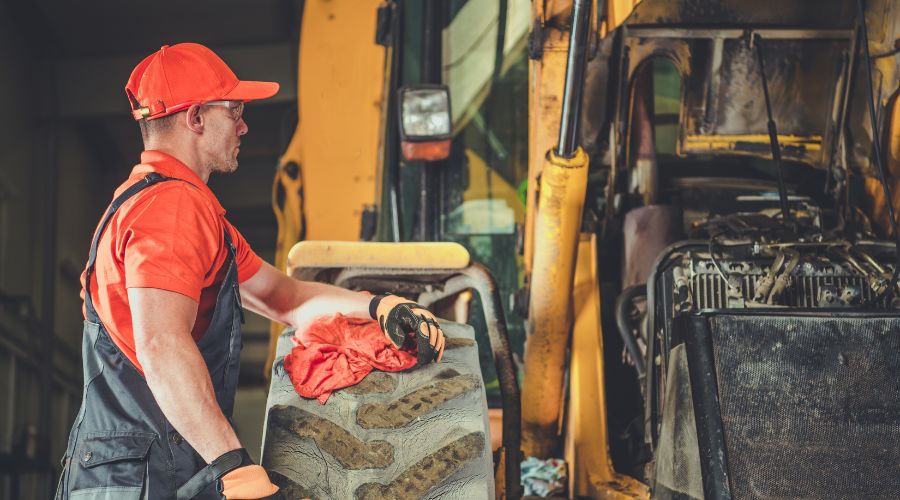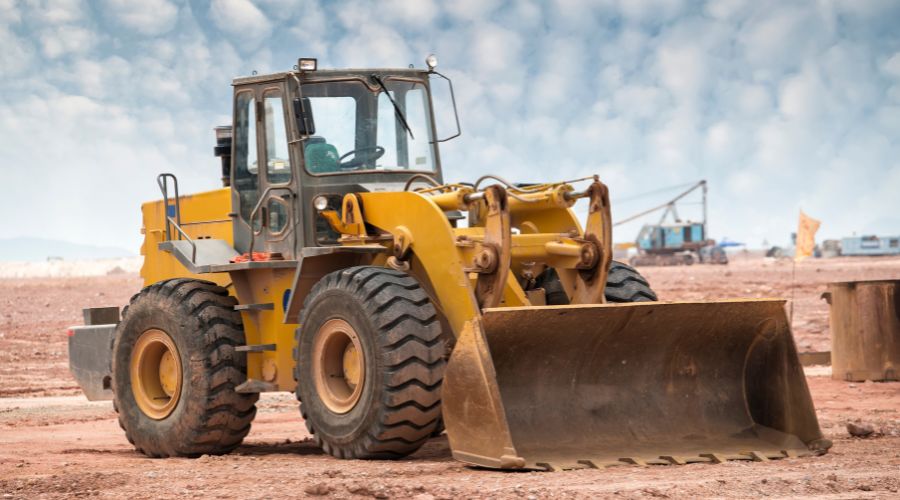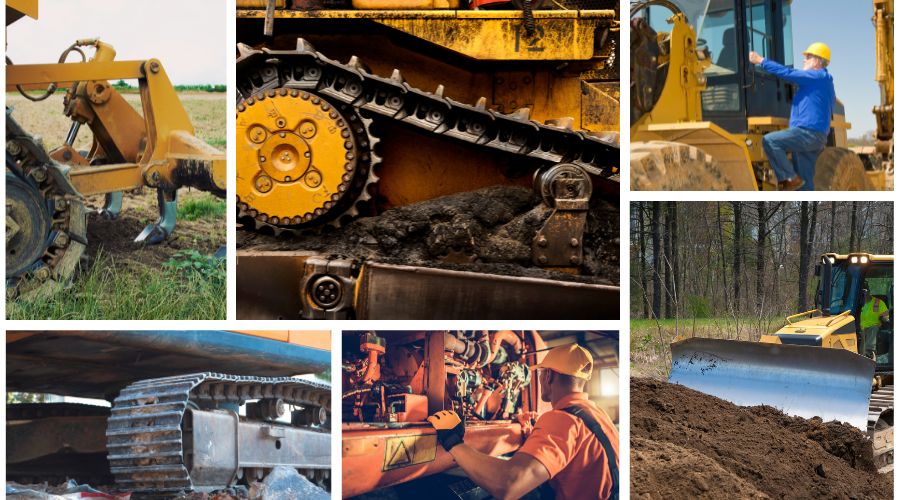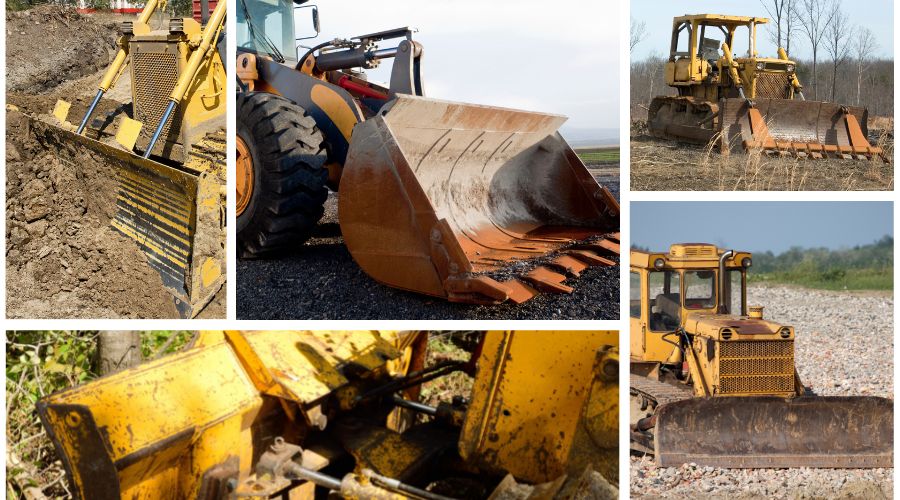A bulldozer is a large and powerful tractor equipped with a wide and heavy blade at the front used for pushing large quantities of earth, sand, rubble, or other heavy materials. It is commonly used in construction, mining, and other industries that require earth-moving capabilities and come in different sizes and models. They are usually operated by a skilled operator who controls the machine using levers and pedals to maneuver the blade and the tracks or wheels.
This guide will cover everything you need to know about bulldozer weight, including common ranges based on size and type of machine. If you’re looking for information on how much a bulldozer weighs, it’s important to first understand that the weight can vary greatly depending on the specific model and features of the machine. Bulldozers come in many different sizes, with smaller dozers weighing around 6,000-10,000 pounds and larger mining dozers weighing over 200,000 pounds.
Check out this blog till last to get complete information about bulldozer weight.
1. Types of Heavy Bulldozers

There are several types of bulldozers, each designed for specific tasks and industries. Here are some of the most common types:
Crawler Bulldozers: These are the most common type of bulldozer and are equipped with tracks instead of wheels, making them ideal for working on rough terrain and in muddy or uneven conditions. Crawler bulldozers typically have a large, heavy-duty blade at the front that is used for pushing and moving materials. The blade can be angled and raised or lowered to control the amount of material being moved. Crawler bulldozers also have powerful engines and hydraulic systems that provide the necessary power to move heavy loads.
Wheel Bulldozers: These bulldozers are equipped with wheels instead of tracks, which makes them faster and more maneuverable than crawler bulldozers. They are commonly used in areas with hard surfaces or on paved roads. These bulldozers are equipped with a ripper—a sharp steel tooth that is dragged behind the machine to break up hardened dirt and rocks. With higher speeds than their track counterparts and improved power transmission, wheel bulldozers are used in a variety of construction or excavation applications.
Mini Bulldozers: These are smaller versions of bulldozers, designed for light-duty tasks such as landscaping and grading small areas. They are also known as compact bulldozers or mini-dozers. With their small size, mini dozers can clear and grade lots, as well as complete a variety of other tasks. Their maneuverability makes them ideal for tight spaces, making them a great choice for jobs that require precise work.
Swamp Bulldozers: These bulldozers are designed for use in swampy or wet conditions. They are equipped with special tracks that distribute their weight over a larger area, preventing them from sinking into the soft or wet ground. Swamp bulldozers are typically used for environmental and land reclamation projects, as well as for pipeline and utility construction in wetland areas. They can also be used for firefighting operations in remote areas where water sources are limited.
2. Why Is a Bulldozer So Heavy?

Bulldozers are heavy machines because they are designed to push, lift and move large quantities of heavy materials such as earth, sand, rubble, rocks, and debris. The weight of the bulldozer provides stability and allows it to exert more force and power while working.
The weight of a bulldozer is also determined by the components used to build it. Bulldozers are typically constructed with heavy-duty materials such as high-strength steel, which makes them durable and able to withstand the stresses and strains of heavy-duty work.
In addition, bulldozers are equipped with powerful engines that can generate a significant amount of torque and horsepower, enabling them to perform their tasks efficiently. The weight of the engine and other heavy components such as the tracks, blade, and hydraulic systems also contribute to the overall weight of the bulldozer.
Overall, the weight of a bulldozer is an important factor in its ability to perform heavy-duty tasks and operate safely and efficiently in various conditions.
3. How Much Does a Bulldozer Weigh?

The weight of a bulldozer can vary depending on its size, model, and configuration. Here are some examples of the weights of different types of bulldozers:
Mini Bulldozers: The mini bulldozer, also known as a compact bulldozer, is the perfect choice for narrow spaces or small lots like driveways. It is similar to the mini excavator in that it is smaller than its standard-sized counterpart. Due to its compact size, it can easily maneuver in tight quarters and complete tasks efficiently. These can weigh between 1,000 and 6,000 pounds (450 to 2,700 kg).
Small Crawler Bulldozers: Small crawler bulldozers are versatile machines that are capable of handling a wide range of jobs, from levelling land for construction to pushing large quantities of soil or debris. These can weigh between 8,000 and 20,000 pounds (3,600 to 9,000 kg).
Medium Crawler Bulldozers: These compact bulldozers are equipped with tracks rather than wheels, which provides improved stability and maneuverability on rough terrain. The weight of medium crawler bulldozers ranges between 20,000 and 60,000 pounds (9,000 to 27,000 kg).
Large Crawler Bulldozers: These sturdy machines accomplish impressive feats and are essential tools in many industries. And weigh over 100,000 pounds (45,000 kg) or more.
Wheel Bulldozers: Wheel bulldozers, also called tire bulldozers, are a type of heavy earth-moving equipment that differ from crawler bulldozers in that they have tires instead of tracks. These can weigh between 20,000 and 100,000 pounds (9,000 to 45,000 kg).
Swamp Bulldozers: Swamp bulldozers also referred to as ‘swampies’, are specially designed or adapted earthmoving machines used for working in swampy, boggy, or wet conditions. These can weigh between 50,000 and 200,000 pounds (22,700 to 90,700 kg).
The weight of a bulldozer is an important factor in its ability to perform heavy-duty tasks and operate safely and efficiently in various conditions. It is important to take into account the weight of a bulldozer when transporting it to and from work sites.
4. Popular Bulldozer Brands and Their Weight

There are several companies that manufacture bulldozers, but here are some of the most popular ones:
Caterpillar: It is one of the world’s leading manufacturers of heavy equipment, including bulldozers. Caterpillar bulldozers come in both crawler and wheel configurations and are available in different sizes and models to meet the needs of different industries and applications. Some of the popular models of Caterpillar bulldozers include the D6, D7, and D8, which are commonly used in construction, mining, and other heavy industries.
Komatsu: This is a Japanese manufacturer of heavy equipment, including bulldozers. They offer a range of bulldozers that are suitable for various applications and environments. Komatsu bulldozers also feature advanced technology and safety features, such as GPS and remote monitoring systems, that help operators work more efficiently and safely.
John Deere: John Deere is a well-known manufacturer of heavy equipment, including bulldozers. Their bulldozers are designed to handle tough jobs, such as grading, pushing large amounts of earth and debris, and other construction tasks. John Deere offers a range of bulldozers to meet different needs and applications, including compact bulldozers for landscaping and small-scale earthmoving, as well as large bulldozers for heavy-duty construction and mining operations.
Liebherr: This German company manufactures a range of heavy equipment, including bulldozers. Their bulldozers are known for their advanced technology and innovative features. Liebherr bulldozers also offer excellent traction and maneuverability, making them ideal for a range of applications, including mining, construction, and forestry. Additionally, Liebherr bulldozers are designed with operator comfort in mind, with spacious cabs, ergonomic controls, and excellent visibility.
CASE: CASE is an American manufacturer of heavy equipment that offers a range of bulldozers for various industries. Their bulldozers are known for their strength and versatility. CASE bulldozers are designed to move large quantities of earth and other materials by pushing them with a large blade attached to the front of the machine.
Hitachi: Hitachi is a Japanese manufacturer of heavy equipment, including bulldozers. Their bulldozers are known for their high-quality components and advanced features. Some common features found in Hitachi bulldozers include powerful engines, advanced hydraulic systems, and operator-friendly controls. Many models also come with advanced technology such as GPS and telematics systems to help operators optimize performance and track machine usage.
| Brand Model | Weight |
|---|---|
| Caterpillar D11 | 248,500 lbs |
| Komatsu D475A-5 | 248600 lbs |
| John Deere 450G | 15932 lbs |
| Liebherr PR 746 Litronic | 67902.4 lbs |
| CASE 1650M | 61,200 lbs |
| Hitachi DX175 | 37566.8 lbs |
These companies are just a few examples of the many manufacturers of bulldozers in the market. Each brand offers different models and features, so it is important to choose the right bulldozer for your specific needs and requirements.
5. What Things Increase The Weight Of The Bulldozer

The weight of a bulldozer is influenced by several factors. Here are some things that can increase the weight of a bulldozer:
Size and Model: The weight of a bulldozer increases with its size and model. Larger bulldozers are generally heavier than smaller ones. For example, a small bulldozer such as the Caterpillar D3 weighs around 16,000 pounds, while a larger model like the Caterpillar D9 can weigh up to 110,000 pounds. The weight of a bulldozer can also vary depending on the attachments and accessories it is equipped with, such as a ripper or winch. It’s worth noting that the weight of a bulldozer is an important consideration when it comes to transporting it to job sites.
Blade Size: The size of the blade attached to the bulldozer can also increase its weight. The blade is one of the heaviest components of a bulldozer, and larger blades require more power to move and control. However, the weight increase from a larger blade can be offset by advancements in materials technology and design, such as the use of lighter, high-strength alloys and improved blade designs that reduce weight while maintaining strength and durability. It’s also worth noting that blade size is not the only factor that determines a bulldozer’s weight. Other factors such as engine size, track size, and overall machine size can also contribute to a bulldozer’s weight.
Additional Attachments: Bulldozers can be equipped with various attachments such as rippers, winches, and root ploughs. These attachments can increase the weight of the bulldozer. For example, a bulldozer equipped with a ripper attachment can weigh several thousand pounds more than the same model without the attachment. Similarly, adding a winch or larger blade to a bulldozer can also increase its weight.
Engine Size: The weight of the engine is just one factor that contributes to the total weight of a bulldozer, but it can be a significant one. Other factors that can affect the weight of a bulldozer include the size and type of tracks, the weight of the blade and any other attachments or accessories, and the overall size and design of the machine.
When selecting a bulldozer for a specific job, it’s important to consider the weight of the machine and how it will affect its performance and maneuverability. A heavier machine may be more stable and better suited to certain types of terrain or tasks, but it may also be more difficult to transport and operate in tight spaces.
Fuel and Fluids: Bulldozers typically require several types of fluids to operate, including engine oil, hydraulic fluid, transmission fluid, and coolant. These fluids are necessary to keep the machine running smoothly and to prevent damage from heat and friction. In addition to fluids, bulldozers also require fuel to power their engines. The amount of fuel required can vary depending on the size and power of the engine, as well as the workload and conditions of the job site.
Protective Equipment: Protective equipment such as roll cages and guards can be added to the bulldozer to protect the operator and the machine from damage. These additions can increase the weight of the bulldozer.
Overall, the weight of a bulldozer is an important factor in its ability to perform heavy-duty tasks and operate safely and efficiently in various conditions. It is important to take into account the weight of a bulldozer when transporting it to and from work sites.
6. Common Uses Of Bulldozers

Heavy bulldozers are versatile machines that can be used in a wide range of industries and applications. Here are some of the most common uses of heavy bulldozers:
Construction: Heavy bulldozers are often used in construction projects, particularly for earthmoving and grading. They can be used to clear land, level the ground, and prepare construction sites.
Mining: Bulldozers are commonly used in mining operations to move large amounts of earth and rocks. They are particularly useful for creating access roads and clearing areas for mining equipment.
Agriculture: Bulldozers can be used in agriculture to clear fields, level land, and create drainage systems. They are often used in land preparation for planting crops.
Forestry: Bulldozers are used in the forestry industry for tasks such as clearing land for logging operations, creating firebreaks, and maintaining access roads.
Landfills: Bulldozers are commonly used in landfill operations for tasks such as compacting and moving waste materials. They are also used to create and maintain access roads within landfill sites.
Demolition: Bulldozers are useful for demolition projects where large structures need to be taken down. They can be used to knock down walls, break up concrete, and clear debris.
Emergency Response: Bulldozers can be used in emergency response situations such as natural disasters to clear roads and debris, and to create access for rescue vehicles.
Overall, bulldozers are powerful machines that are essential in many industries and applications. They are particularly useful for tasks that require heavy lifting, earthmoving, and ground preparation.
Conclusion
Bulldozers are large, heavy-duty vehicles used for earthmoving and construction work. The weight of a bulldozer can vary depending on its size and model. On average, a standard bulldozer weighs around 10 to 20 tons (9 to 18 metric tons), while the larger models can weigh up to 200 tons (181 metric tons) or more. The weight of a bulldozer plays an important role in its use, allowing it to apply the necessary force needed for excavation and other tough jobs.
Recommended:
- Discover The Hidden Cost Of Smart Meters: Energy Consumption
- Click Here To Find Out The Reliable Building Maintenance Companies In Melbourne!
- Moving Made Easy With The Best Movers In Adelaide

